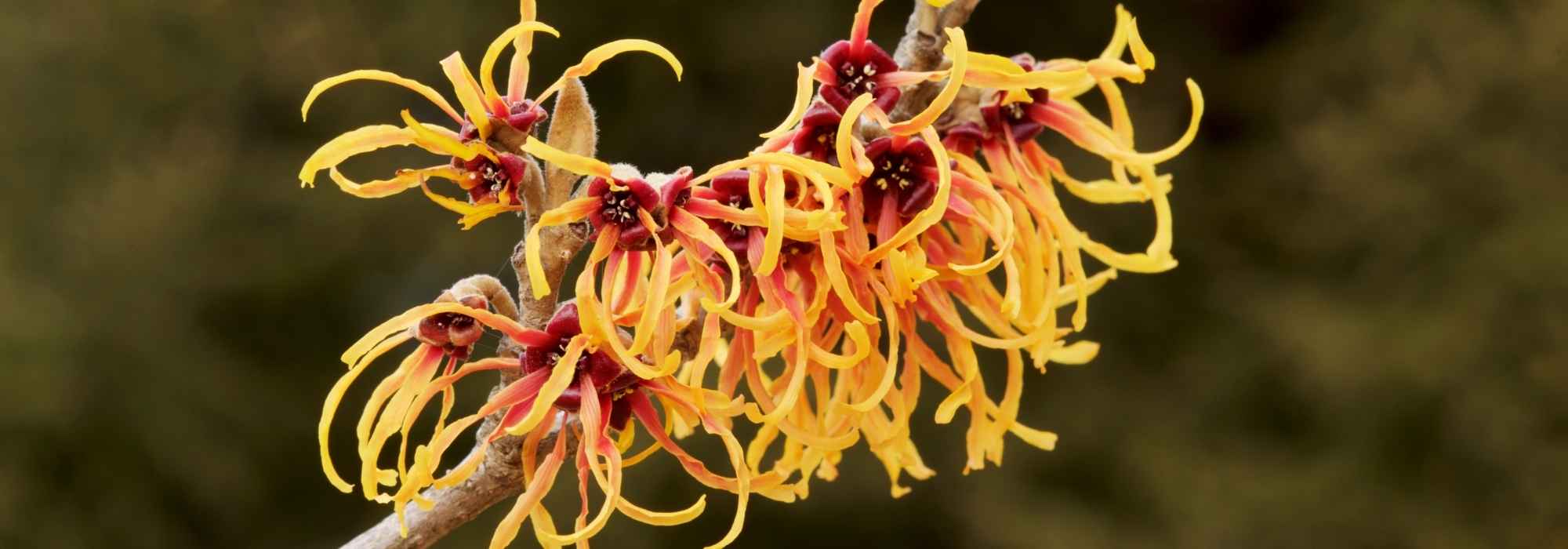
Hamamelis: 7 ideas for successful combinations
In various situations
Summary
Hamamelis is still fairly little used in gardens, yet what a show for this bush, king of winter and also of autumn! Hamamelis (mollis or virginiana) expresses itself joyfully from December in the loveliest way with a warm flowering in shades of yellow, orange to purple, on the naked branches. Its almost bicolour flowering, with crimson or carmine calyces, contrasts with ultra-bright petals that look torn. A hard frost? Petals curl and roll up, then unfurl into fine ribbons as temperatures rise again. Hamamelis are not bothered by frosts, and are among the few bushes that bring colour to our gardens through the long months, until the end of winter. They also enhance the garden during autumn when their foliage takes on yellow and coppery tones. Finally, their unrivalled hardiness (down to −30°C for some cultivars) allows planting across France!
Superb planted singly, highlighting their spreading habit and distinctive flowering, Hamamelis lend themselves to many elegant planting combinations in the garden, within exuberant mixed borders or in a natural style, in partial shade or full sun. Discover a few easy-to-recreate displays to showcase these inspiring ornamental bushes, so easy to grow!
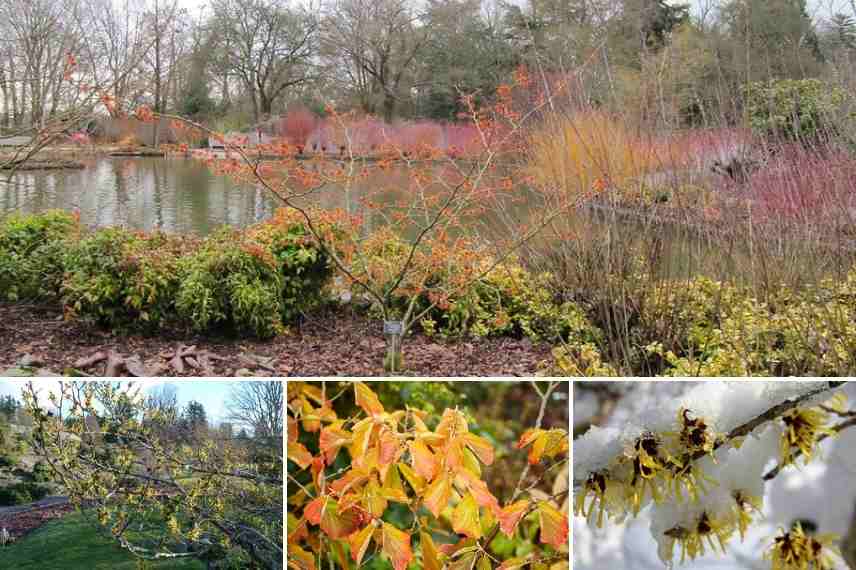
Hamamelis, superb in natural scenes (Photo : L. Enking and W. Cutler), autumn colouring, flowers under snow…
→ Discover our complete guide on Hamamelis
Standing alone!
The originality of the flowering on the naked wood of Hamamelis deserves a prime place in the garden! It is never more beautiful than when showcased on its own, on a short grass meadow or by the house to enjoy its scent.
To enhance it without stealing the show, it should be paired with groundcover plants that will form a luminous evergreen tapetum perennial, and that will not compete with its winter brilliance. It is simply perfect accompanied by bulbs with spring or autumn flowering, planted in large drifts, which will take over when it is not or no longer in flower, such as dwarf narcissi, Cyclamen coum, colchicums. A few snowdrops will accompany its flowering, while hellebores (oriental and foetidus) will brighten its base in midwinter, creating a decorative evergreen foundation all year round.
You may also read
Witch hazel: planting, growing, care, and pairing ideasIn a Winter garden
The winter garden trend, imported a few years ago by our English gardener friends, is a boon for showcasing Hamamelis in winter in an enchanting setting that highlights remarkable bark, flowering, foliage and decorative winter wood!
Choose a Hamamelis mollis, slightly smaller in size, to compose a large mixed bed of bushes and perennials that showcases it, accompanied by other bare trees and branches creating plays of transparency: Cornus with decorative wood, Clethra with beautiful exfoliate bark and foliage glowing red in autumn, winter heathers (Erica carnea) in soft tones, light grasses that hold frost in winter, combined with some contrasting evergreen foliage in golden or bluish greens (junipers, chamaecyparis).
An orange-toned bed might, for example, combine some Cornus sanguinea ‘Magic Flame’ and flavimarea, summer heathers, Carex comans ‘Bronze Form’ and Carex testacea, some Panicum virgatum, a Chamaecyparis obtusa ‘Gold Drop’, and specimens with magnificent bark such as Prunus serrula, Acer griseum, or Rubus thibetanus.
A palette of pinks and reds can pair Hamamelis ‘Ruby Glow’ with some Cornus alba ‘Baton Rouge’ and sibirica, a few blue fescues, Bergenias, a Salix purpurea ‘Nana’ or a Salix rosmarinifolia with fine green foliage, etc.
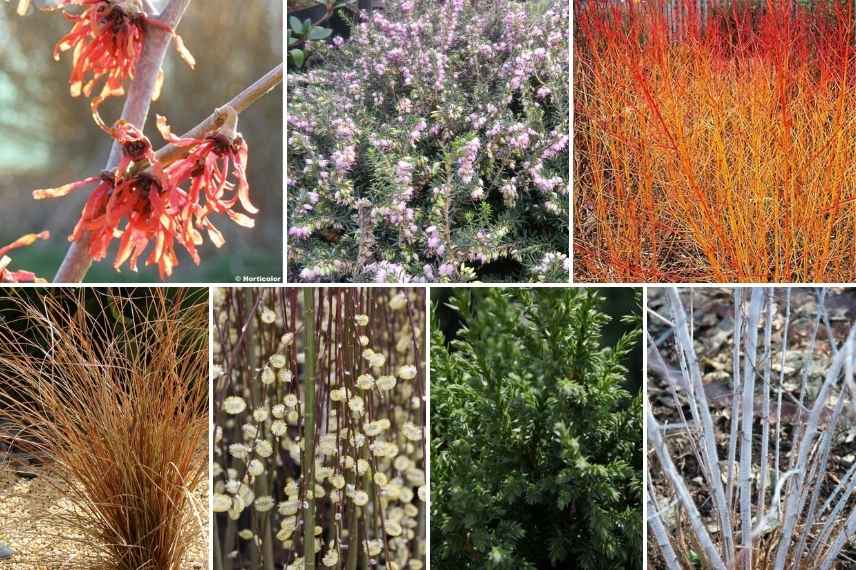
Hamamelis Intermedia ‘Diane’, Erica Darleyensis ‘Darley Dale’, Cornus sanguinea ‘Magic Flame’, Carex comans, Salix caprea ‘Kilmarnock’, Juniperus squamata ‘Loderi’, Rubus thibetanus ‘Silver Fern’
Discover other Winter-flowering shrubs
View All →Available in 0 sizes
Available in 1 sizes
Available in 1 sizes
Available in 1 sizes
Available in 1 sizes
Available in 1 sizes
Available in 2 sizes
Available in 1 sizes
Available in 1 sizes
Available in 1 sizes
In a cottage garden
Hamamelis also lends itself very well to a country atmosphere. It is the very natural habit and the superb autumn colours of Hamamelis virginiana that interest us for this bocage-inspired use in a natural garden.
In a bright position or in partial shade, Hamamelis harmonises with other beds of deciduous bushes delicately in flower, with supple habits and yellow to orange hues.
There are many possibilities for this rural ambience: for example, you can combine simultaneous flowerings with a Cornus mas and a Chimonanthus praecox, the latter also scenting the garden, a few forsythias, a Japanese quince and a Lonicera fragantissima also fragrant. By adding a few shrubs such as dwarf willows you will add a lower stratum that is visually interesting and the graphic lines of coloured wood standing upright in winter.
Feel free to complete this palette that will immediately evoke bocage with some natural grasses and some bulbs whose spring flowering will prolong the magic of these shrubs: Carex testacea, snowdrops, scillas, daffodils…
You may also read
Hamamelis: the most beautiful varietiesIn a bed of acidic soil
Hamamelis plants naturally find their place in a bed of heather soil, preferring slightly acidic soil. Pairing them with lower bushes that thrive in this type of soil, such as Pieris, Kalmia, Azaleas and Rhododendrons, is a happy match, especially as these bushes will take over by flowering in mid-spring. To brighten their dark foliage, introduce touches of lighter foliage and winter flowering that will echo its flowering: acid-hued Hachonekloas and a Loropetalum ‘Red in Black’, of the same family as Hamamelis, will echo its flowering with fine ribbons. Heathers flowering all summer will prolong the appeal of this type of bed that enlivens spring.
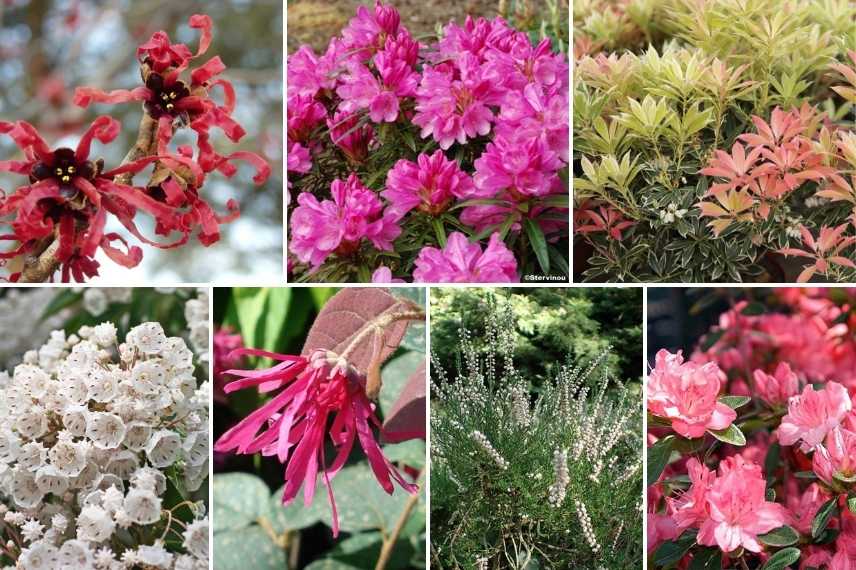
Hamamelis, Japanese azalea ‘Purple Splendor’, Pieris ‘Flaming Silver’, Kalmia latifolia ‘Elf’, Loropetalum, Calluna vulgaris ‘Alba’, Rhododendron ‘Graziella’
At the woodland edge
It is always interesting to recreate, when climatic and soil conditions allow, the natural habitat of a tree or a bush. Hamamelis originally grow in leafy forests in China. Do you have a large garden with understorey areas and are unsure how to landscape them?
Planted in semi-shade, Hamamelis will provide a gentle transition to a wilder part of the garden. In this setup, several varieties of Hamamelis will be planted in a small clump (in odd numbers, 3 or 5) at edge of understorey. They will be accompanied by other bushes with a loose habit to create a very natural effect, and a hardy ground cover. Acer campestre, Corylopsis (or False Hazel) of the same family as Hamamelis with lightly scented pale yellow flowering, Ilex, Euonymous alatus, Salix matsudana with its magnificent twisted winter habit easily accompany Carex pendula, Amsonia hubrichtii with blue flowering and sublime autumn colour.
In a Japanese-style border
To evoke a Japanese-inspired atmosphere, compose spring and autumn scenes and play with sculptural habits: the flared silhouette and atypical flowering of Hamamelis give it that orientalising spirit. A very wide range of plants can help maintain this mood in pink and purple tones that evoke Japan.
A Hamamelis with purple flowering will look splendid alongside bushes with delicate pink or white flowering occurring at the same time then in spring, evoking land of the rising sun (Edgeworthia so graphic and sculptural, Viburnum bodnantense, ornamental Malus with magical mini apples coloured in winter, Magnolia serrata and Rhododendrons in high season…). Some evergreens with dark or purple foliage will support this setting: Oxydendrum arboreum (Pieris in tree form), Skimmias, Pieris, while pruned bushes or topiaries can add to the strong symbolism of Japanese gardens, such as a Cryptomeria compacta or an Ilex crenata. An Acer palmatum Dissectum completes the orientalist illusion, which becomes almost perfect when horizontal habits provided by conifers such as Juniperus squamata are added to the bed.
This shrubby ensemble can be enhanced by a few perennials and evergreen groundcovers to create a contrasting tapetum: Hackonekloas luminous, Ophiophogons black, Hostas. This Japanising decor will be enriched with some rocks and mineral elements, key features of Japanising spirit.
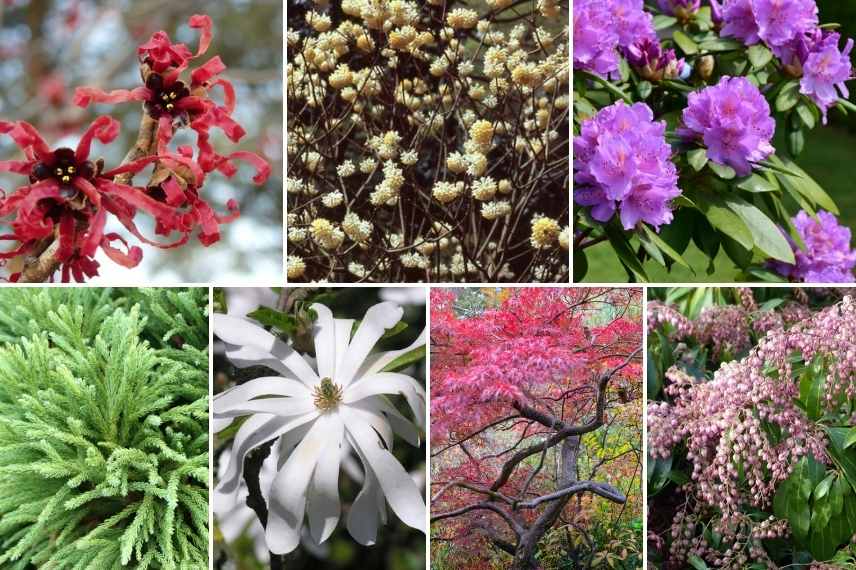
Hamamelis vernalis ‘Amethyst’, Edgeworthia, Rhododendron, dwarf Cryptomeria, Magnolia stellata, Japanese maple, Pieris japonica ‘Katsura’
In a vibrant border
Warm tones of Hamamelis can provide inspiration for a very bright winter scene, bringing warmth to a rather bleak spot: Hamamelis truly deserves a prime place in front of a screen of evergreen bushes, a dark-green hedge against which its brilliant flowers will stand out. Dare to create an ultra-coloured bed with vivid blooms, composing with this colour palette that sets the garden alight during the coldest months. Combine several bushes and perennials in the same palette so they will flower afterwards, in spring and then in summer.
Create a vibrant bed in pinkish tones with a Hamamelis vernalis ‘Amethyst’, which will harmonise with reds, purples and green and blue foliage: autumnal blaze of Euonymus alatus ‘Burning Bush’, the frayed flowering of Loropetalum, shimmering fruits of Callicarpa japonica and skimmias, Pieris japonica Katsura, Helleborus orientalis, striking stems of Cornus alba ‘Elegantissima’, and spring and summer blooms to come: Botanical tulips in scarlet, Camellia japonica, Physocarpus, Astrantia major ‘Claret’. A few Carex comans ‘Frosted Curls’ will fill these colourful areas with their blue-tinged evergreen foliage.
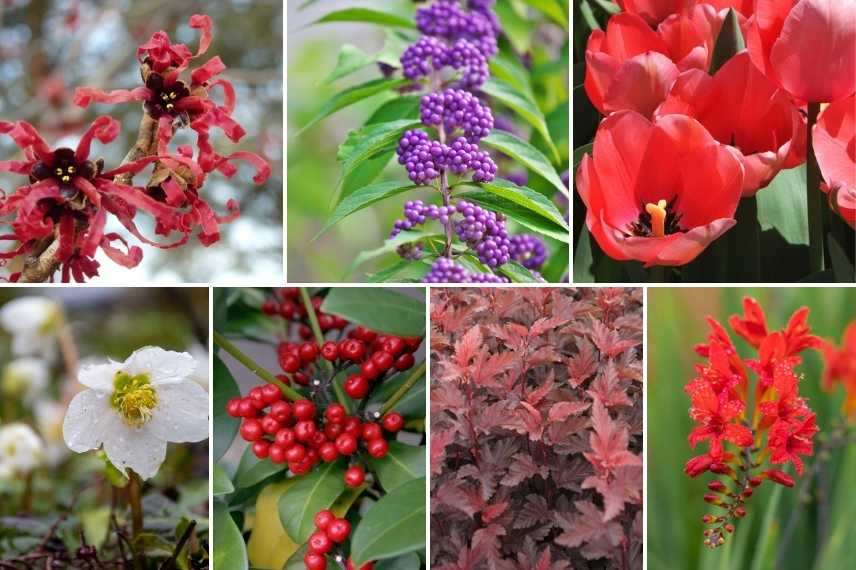
Hamamelis, Callicarpa, Botanical tulips, white hellebore, Skimmia japonica, Physocarpus opulifolius ‘Lady in Red’, Crocosmias ‘Lucifer’
For a lively version, bright yellow to orange blooms will be highlighted with contrast of blue or purple touches that will underline warm tones in different seasons: Mahonia ‘Soft Caress’, Edgeworthia, hellebores, botanical tulips for winter flowering; rhododendron, azaleas, creamy magnolias in spring, followed in summer by coppery-orange agastaches, kniphofias, Alstroemeria aurantiaca… Heucheras ‘Caramel’ and Hakonechloa macra ‘Aureola’ form superb groundcovers. A few Geranium pratense ‘Midnight Reiter’ or ‘Suzanne’ and Caryopteris will subtly contrast the orange palette…
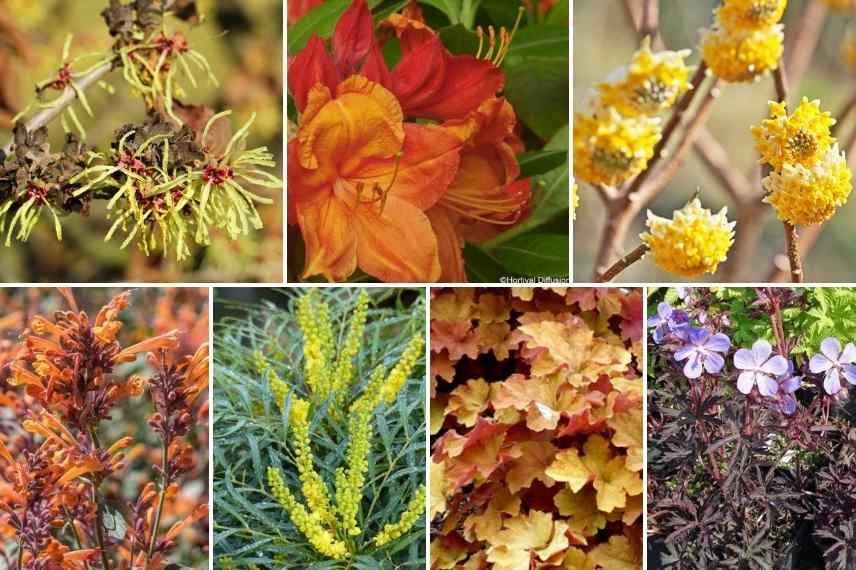
Hamamelis ‘Pallida’, Rhododendron ‘Glowing Embers’, Edgeworthia, Agastache ‘Kudos Mandarin’, Mahonia ‘Soft Caress’, Heucheras ‘Caramel’, Geranium pratense ‘Midnight Reiter’
You really have plenty of choice in this festival of colour… To make these beds work all year, provide blooms and foliage that unfold season after season for an always striking effect. Your turn!
- Subscribe!
- Contents
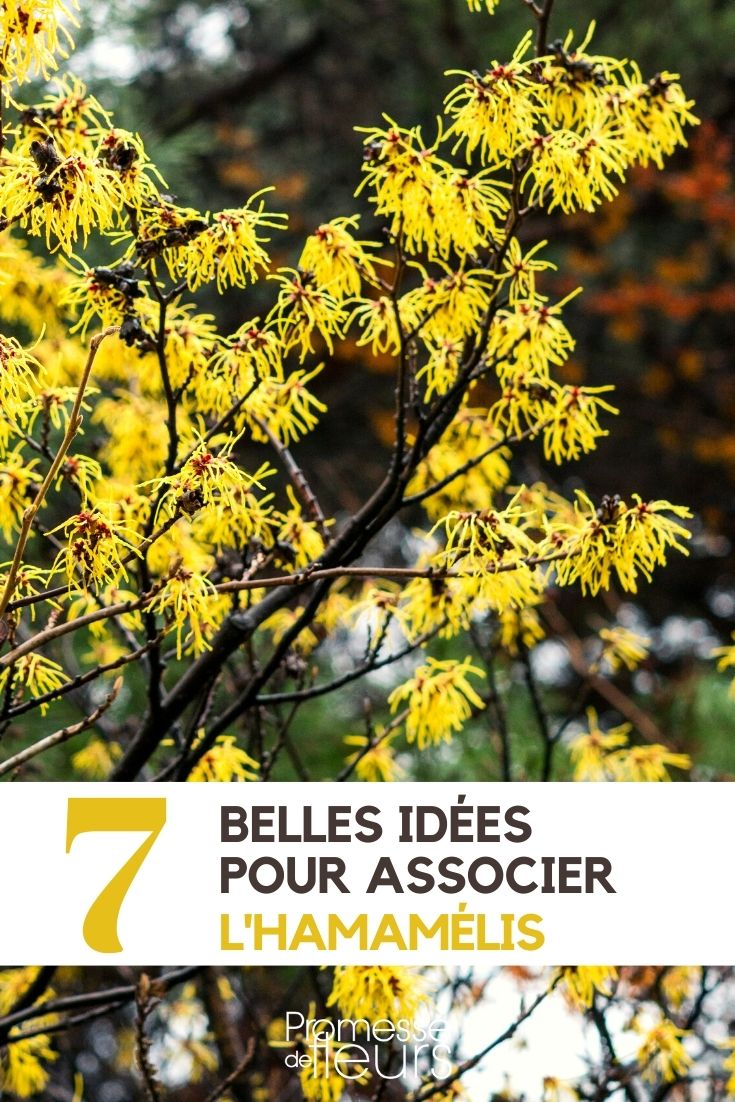































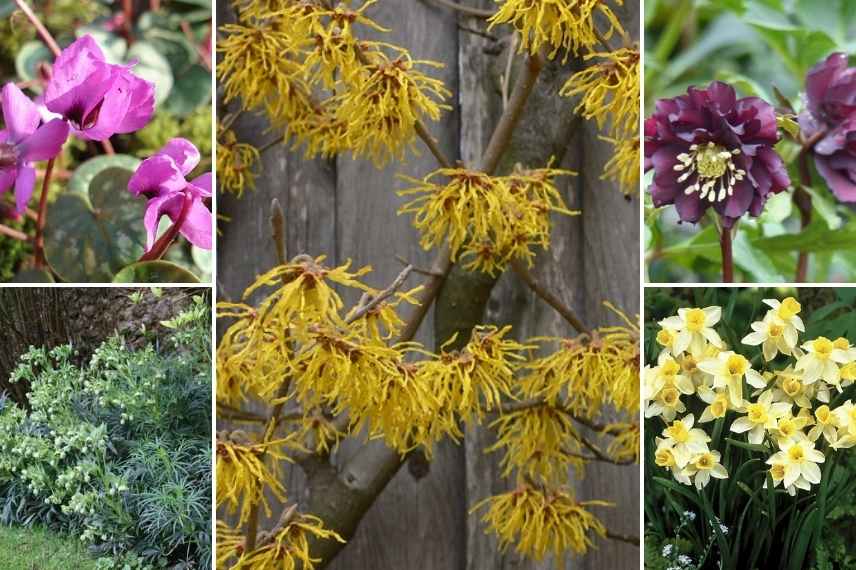


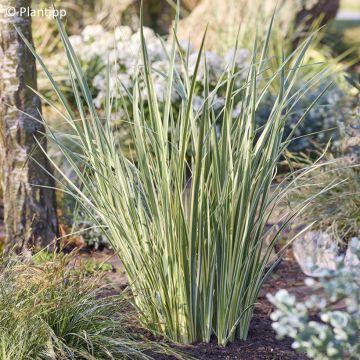
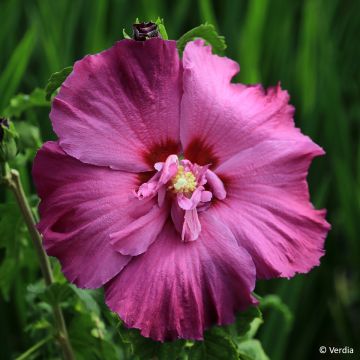
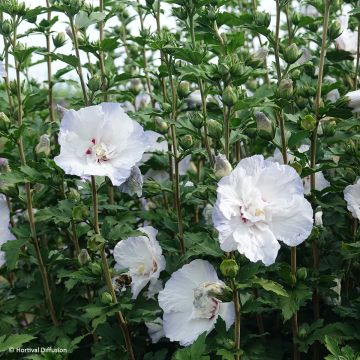


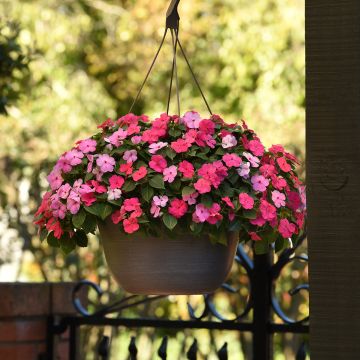
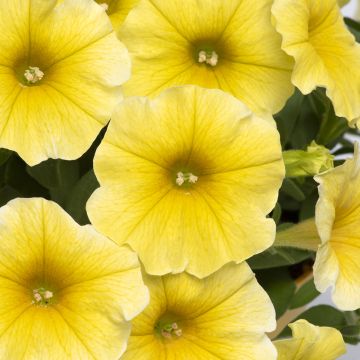
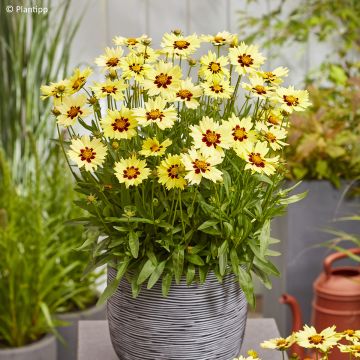
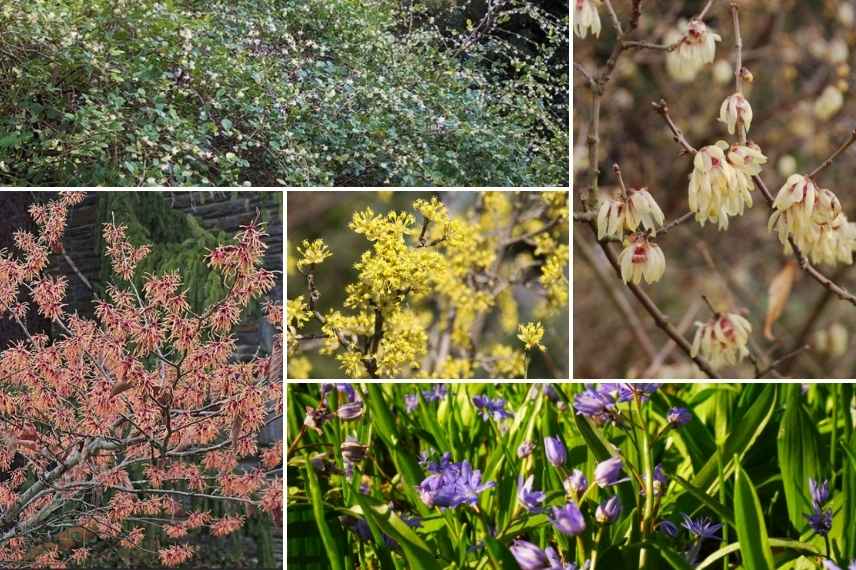
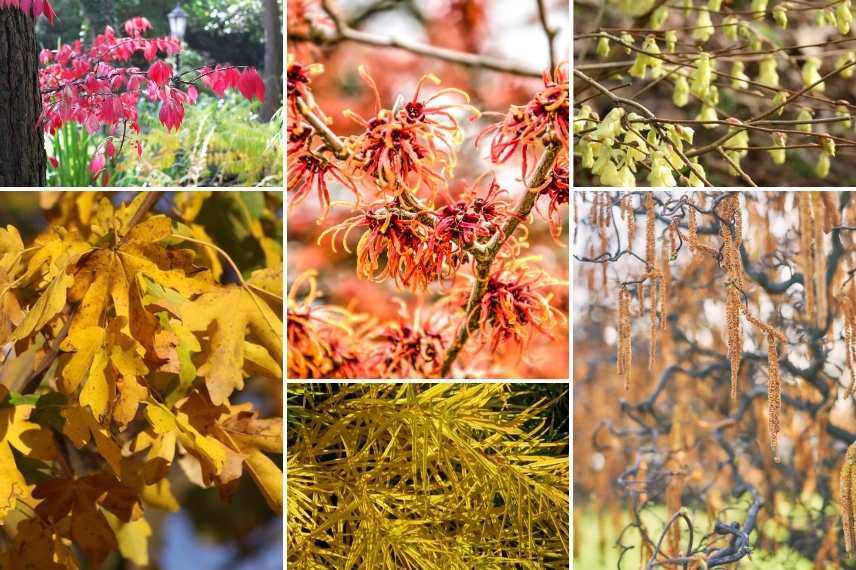
Feedbacks